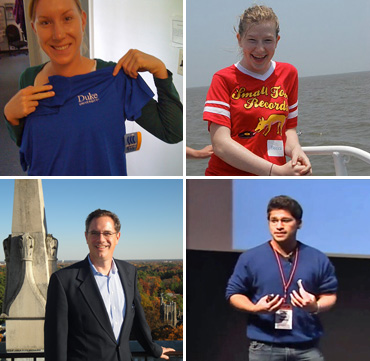By Becca Bayham
 “There are the thermometers who passively record social injustices, and then there are the thermostats that actively do something about it,” Dr. Sunny Kishore said during the Eureka Symposium last Saturday, a dPS-sponsored event that brought together 120 students and a number of Duke alums for some deep thinking about social change.
“There are the thermometers who passively record social injustices, and then there are the thermostats that actively do something about it,” Dr. Sunny Kishore said during the Eureka Symposium last Saturday, a dPS-sponsored event that brought together 120 students and a number of Duke alums for some deep thinking about social change.
The main lecturers were followed by break-out sessions, which ranged in topic from global health to human rights. The four-hour symposium packed a philosophical punch, outlining a few actions that could save millions or even billions of lives in the developing world. It’s probably the most inspired I’ve felt on a Saturday afternoon.
Representatives from the Enough Project made the case for using conflict-free minerals on campus (similar to the idea behind conflict-free diamonds). Tin, tantalum, coltan and gold — used in cell phones and other electronics — currently fuel war in eastern Congo, where various armed groups mine them for profit; more than five million people are thought to have died from the conflict so far. (Following a rather pointed editorial in the Chronicle by two Symposium organizers, Duke Procurement stated on its website that it would “[give] preference to vendors who have made a commitment to conflict-free supply chains when quality and cost performance are equal or superior.”)

Drs. Anthony So, Robert Johnston and Kishore discussed strategies that could provide people in developing nations with access to life-saving treatments and vaccines — at a price they can afford. Triple therapy for AIDS used to cost $10-15,000, “too high a price for hope,” So said. But thanks to ‘bootstrap philanthropy’ — free licenses and free production, supported by grant money — that same treatment costs less than $100 now.
Royalty fees and license exclusivity have usually put vaccines out of reach for the developing world, unless the drug is off-patent. Johnston (of Global Vaccines, Inc.) proposed one solution: commercial sub-licenses, which allow low-cost manufacturers to produce affordable vaccines without violating companies’ intellectual property rights.
“You have the ability to have a drug at first-world prices in developed countries and can now provide lower-cost medicines in developing countries,” Kishore said.
Research universities could play a pivotal role by allowing “humanitarian licenses” of their technologies, according to Kishore. Several universities — Duke among them — have signed a statement supporting dissemination of medical technologies, but not much progress has been made.
“Are we engaged in rhetoric or are we engaged in actually doing something?” Kishore said. “These are our labs, our drugs, and this is our responsibility.”









